Innovative Non-Permanent Deck Solutions for Modern Homes
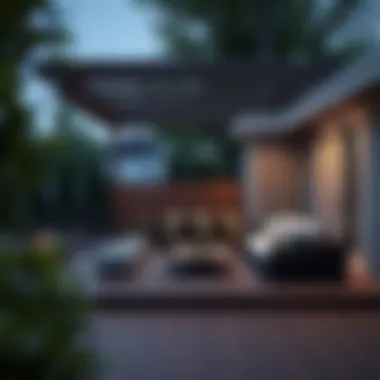
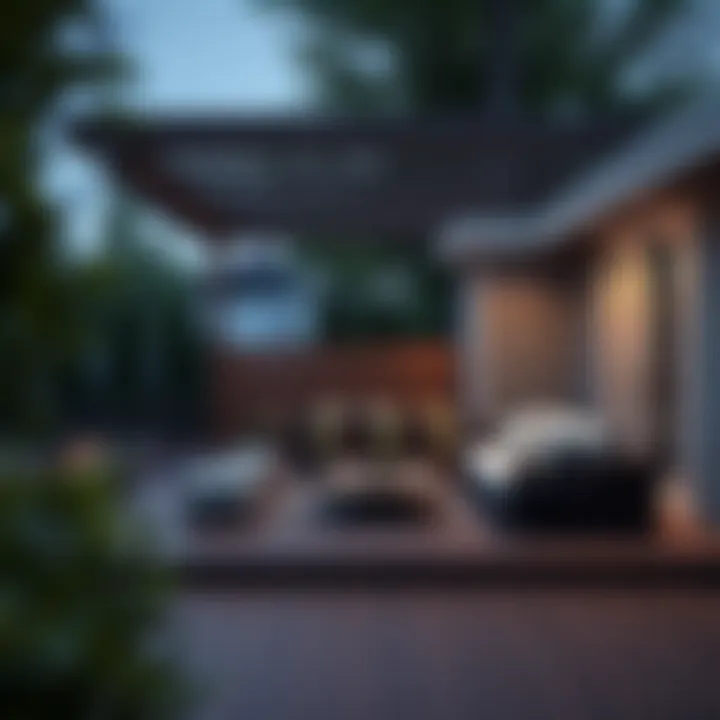
Intro
In today’s world, where outdoor living spaces are becoming a priority for many homeowners, the idea of non-permanent decking solutions is taking root. The flexibility, temporary nature, and aesthetic appeal of these decks allow for a transformation of spaces without the commitment of traditional installations. Non-permanent decking can range from modular systems to portable panels, catering to various tastes and lifestyles. This article sets out to unravel the layers of non-permanent decks—from the myriad of materials used to how they can be installed, as well as their maintenance needs. We will guide you through the current trends in outdoor design and the key considerations in selecting the right deck for your unique needs.
Furniture Trends and Styles
Outdoor furniture trends are evolving to match the changing needs of homeowners. With increasing focus on creating versatile spaces, the furniture we choose for these areas plays a vital role. Non-permanent decking doesn’t just lend itself to flooring; it ties together the overall look with furniture that complements its style.
Current Trends in Furniture Design
These days, outdoor furniture is more than just a place to sit. It emphasizes comfort and versatility. Here are some trends currently carving out the market:
- Eco-Friendly Materials: Many homeowners are opting for sustainably sourced materials that minimize environmental impact, like reclaimed wood or recycled plastics.
- Modular Pieces: Furniture that can be rearranged or combined to fit different gatherings or activities is gaining popularity. Think sectionals that can be configured in a variety of ways.
- Bold Colors and Patterns: Adding splashes of color or unique patterns to furniture creates visual interest. This can offset the earthy tones commonly found in non-permanent decks.
Popular Furniture Styles and Their Characteristics
Without a shadow of a doubt, specific styles are resonating more than others in today’s outdoor furniture landscape:
- Modern Minimalism: Clean lines and a simple color palette characterize this style, making it adaptable to various non-permanent deck designs.
- Bohemian Vibes: Layers of textured cushions, eclectic patterns, and vibrant colors help to create a warm and inviting atmosphere, perfectly balancing casual outdoor settings.
- Industrial Look: Think steel and wood combinations that highlight raw textures. This style complements the rustic appeal of non-permanent decking.
Buying and Maintenance Guides
When it comes to choosing outdoor furniture to match your non-permanent deck, some vital considerations come into play. With an array of options at your fingertips, here's how to navigate through them.
Essential Tips for Purchasing Furniture
- Inspect the Material: Before you make a purchase, determine the material composition. Will it withstand diverse weather conditions? Look for UV-resistant options.
- Shape and Size Matter: Ensure the pieces fit your outdoor layout. For space-limited areas, lean towards compact, multifunctional furnishings.
- Comfort is Key: If you plan to enjoy long evenings outdoors, invest in ergonomic designs with ample cushioning.
Maintenance and Care for Different Furniture Materials
- Wood: Requires regular sealing to protect against moisture and UV damage. Clean with a gentle solution and avoid abrasive tools.
- Metal: Best to look for rust-resistant options. Regular cleaning with mild detergent keeps it looking fresh.
- Fabric: Choose weather-resistant textiles. Most can be cleaned with soap and water, and it's wise to store them indoors during extreme conditions.
"Investing in the right outdoor furniture is not just about aesthetics but also about ensuring longevity and comfort."
All in all, the appeal of non-permanent decks lies in their adaptability and ease of use. As the outdoor living trend expands, synergies between materials, styles, and furniture continue to flourish, presenting exciting opportunities for homeowners eager to craft their personal paradise.
For more about eco-friendly materials or modern outdoor designs, check out resources from Wikipedia, Britannica, or other related articles on Reddit. Remember, a well-planned outdoor space can elevate your home in numerous ways.
Foreword to Non-Permanent Decks
As outdoor living spaces gain traction in our homes, the concept of non-permanent decks emerges as a noteworthy consideration. These decks serve a dual purpose; they not only enhance the aesthetic appeal of a space but also offer adaptability that traditional, permanent structures cannot match. Homeowners, designers, and DIY enthusiasts are increasingly gravitating toward these versatile options, as they provide the perfect solution for creating stylish and functional outdoor areas without the long-term commitment associated with conventional decking.
The importance of understanding non-permanent decking lies in its ability to cater to a variety of needs. With the right materials and designs, these decks can transform any area into an oasis of relaxation, social gatherings, or even simple recreational spots for families.
"Flexibility in design yields infinite possibilities; non-permanent doesn't mean less significant."
In essence, non-permanent decks are about freedom. They offer a chance to create spaces that can be easily modified or completely removed according to changing preferences. This allows homeowners to easily update their outdoor environments in a cost-effective manner.
Defining Non-Permanent Decks
When we talk about non-permanent decks, it’s essential to clarify their characteristics. Simply put, a non-permanent deck is any outdoor surface that does not require an extensive foundation or long-term commitment. They can be easily assembled, disassembled, or relocated, making them perfect for those who might rent properties or wish to have the flexibility of moving their outdoor living spaces.
Materials often used in these decks include wood composites, plywood, and interlocking plastic systems. A defining feature is their lightweight nature, which allows for straightforward installation without heavy machinery or permanent foundations. Many designs can include features such as modular tiles that click together or retractable options, providing an effortless solution for anyone looking to enhance their outdoor area without the high stakes of commitment.
Rationale Behind Non-Permanent Structures
The rationale for embracing non-permanent structures is multifold. For one, they reflect a shift in how outdoor spaces are used and perceived today. As modern living requires flexibility—due to lifestyle changes or family dynamics—non-permanent decks adapt accordingly. Here are some considerations:
- Environmental Concerns: With the growing awareness of sustainability, using non-permanent materials often translates into lower waste and less environmental impact. Homeowners can opt for recycled or biobased materials without sacrificing aesthetics.
- Regulatory Simplicity: In many regions, non-permanent structures often face fewer restrictions than their permanent counterparts. This means homeowners can avoid the lengthy approval processes that sometimes come with building codes.
- Cost and Investment: Compared to permanent options, non-permanent systems usually entail a significantly smaller financial outlay. Homeowners can invest in quality materials without breaking the bank while also being able to reconfigure or upgrade their decks over time.
In sum, non-permanent decking solutions are evolving into a practical choice for modern living. They cater not only to individual tastes but also align with economic, environmental, and regulatory trends in today's society.
Benefits of Non-Permanent Decking
Non-permanent decking solutions are increasingly becoming a noteworthy alternative in contemporary outdoor design. Their significance lies not only in their aesthetic appeal but also in their practicality. By using non-permanent materials, homeowners can achieve a desired look while maintaining the flexibility to modify or replace their setups as life circumstances change. Non-permanent decking offers a range of benefits that can enhance the quality of outdoor spaces, fostering environments that are functional yet stylish.
Flexibility in Design
One of the standout advantages of non-permanent decks is their unparalleled flexibility in design. Homeowners can play around with various configurations, layouts, and finishes without the burden of permanent commitments. For instance, using interlocking wood tiles, one can create a cozy nook in the backyard during summer and transform it into a vibrant entertaining area for gatherings. The ability to easily adjust the design to reflect personal tastes or seasonal trends allows for a refreshing change that complements shifting feelings or events in life.
"Flexibility elevates functionality; a versatile deck is as dynamic as its owner’s aspirations."
Cost-Effectiveness
When it comes to budgeting for outdoor improvements, non-permanent decking often proves to be a more cost-effective choice. Unlike traditional wooden decks that require significant financial investment in both materials and labor, non-permanent options, such as composite planks or modular systems, usually have a lower entry price. Additionally, because they require less maintenance and fewer long-term repairs, overall costs dwindle. This allows homeowners to enjoy attractive outdoor spaces without breaking the bank, freeing up funds for other home improvement projects.
Ease of Installation
Installation is another area where non-permanent decking shines. Most types can be installed without professional assistance, making them a handyman's delight. Many systems simply snap, lock, or fit into place, which means many DIY enthusiasts can take the reins when it comes to installation. For example, using deck tiles that require no adhesive or tools can save time and effort. Moreover, this user-friendly approach caters to a broader audience, empowering individuals to create their outdoor oasis without the need for hefty labor costs.


Seasonal Adaptability
The ability to adapt to seasons is crucial for any outdoor setup. Non-permanent decks empower homeowners to easily modify their space throughout the year. During warmer months, a deck can transform into a serene sunbathing platform sprinkled with potted plants and cushions. When temperatures drop, the same space can make way for winter decor, such as fire pits and cozy seating arrangements. This seasonal adaptability promotes the constant use of outdoor areas across different times of the year, maximizing enjoyment and utility for the entire household.
Material Options for Non-Permanent Decks
Choosing the right materials for non-permanent decks is crucial. This choice affects everything from durability to aesthetic appeal, reflecting the personality of the homeowner while meeting practical needs. Each material comes with its own strengths and weaknesses, and understanding these can empower homeowners and designers to make informed decisions.
Wood Composites
Wood composites stand as a popular option among homeowners who desire a natural wood look without the burdens of traditional lumber. These materials often combine recycled wood fibers and plastic, yielding a robust solution for outdoor spaces.
One of the advantages is their resistance to rot and insects. This makes them ideal for various climates, especially where moisture can be a challenge. Additionally, wood composites require less maintenance than their natural counterparts. They don’t need regular staining or sealing, simply requiring periodic cleaning with soap and water to restore their appearance.
Considerations when opting for wood composites:
- Cost: While generally more affordable than traditional wood, some higher-end composites can still make a dent in the budget.
- Fading: Although they are treated for UV protection, over time, colors may still fade, which may not sit well with all homeowners.
- Environmental Impact: They utilize recycled materials, making them a more eco-friendly choice compared to pure plastic.
Plywood and Deck Tiles
Plywood and deck tiles provide an incredibly versatile option for designing non-permanent decks. Plywood is often used as the base, especially in DIY projects, allowing for creativity in shapes and layouts. More refined woodworking can be achieved with deck tiles, which can easily be snapped together, offering a clean, polished look without complex installation.
This method often appeals to those who want an easy setup that can be modified or removed with minimal effort. Deck tiles can be made from composite wood, ceramic, or even stone, each bringing a unique flair to outdoor spaces.
Key benefits of plywood and deck tiles include:
- Ease of Installation: Assembling tiles and cutting plywood can often be handled without professional help.
- Cost-Effectiveness: Both materials can be more economical than traditional decking solutions, especially for larger areas.
- Customizability: Plywood and tile options allow for diverse designs and patterns.
Interlocking Plastic Systems
Interlocking plastic systems represent another innovative material for non-permanent decks. These come in modular pieces that fit together seamlessly, creating a sturdy yet lightweight surface. They’re manufactured from high-density polyethylene or polypropylene, enhancing their resistance to weather and wear.
The benefits of these systems are manifold. They are straightforward to install and can often be laid down without a special substructure. Homeowners can create various configurations depending on their space, making it an ideal choice for those looking to change designs regularly.
Benefits of interlocking plastic systems include:
- Durability: Resistant to moisture, fading, and wear, these materials tend to last longer in demanding outdoor conditions.
- Low Maintenance: A simple rinse will usually suffice to keep these decks looking fresh.
- Portable: Easy to dismantle and relocate, these decks cater well to renters or those who frequently move.
Incorporating the right material is key to achieving a balance between functionality and aesthetics in non-permanent decks. By understanding the characteristics and advantages of various options, homeowners can make informed choices that enhance their outdoor living experience.
Design Considerations for Non-Permanent Decks
When thinking about non-permanent decks, design considerations can make or break the project. It's not just about throwing down some boards and calling it a deck. Homeowners need to think about how these structures will fit into their lives and their spaces. Do you have a cozy nook on your balcony, or are you dreaming of a sprawling space for gatherings? These elements influence not only the aesthetics but the utility of the deck as well. Understanding the right design approach enhances the value and versatility of outdoor areas.
Assessing Available Space
Before getting into details, assessing the available space is key. Whether you have a small back patio or a spacious garden, measurements matter. Dig out that tape measure and jot down dimensions. Recognizing where your deck will sit allows for effective planning, ensuring that it won’t crowd out other elements like pathways or plants.
Let’s not forget about access; you don’t want to block doors or windows. Also, consider how the space interacts with the sun—shady spots might need more thought for using solar-powered lights.
Complementing Existing Styles
Complementing existing styles brings unity to your outdoor area. If your house has a rustic charm, choosing wooden composite materials might augment that aesthetic. For a sleek, modern look, you’d be better off with interlocking plastic systems that offer clean lines.
Matching colors and finishes can create a seamless look between your deck and the surrounding architecture, preventing any jarring contrasts that can be an eyesore. As a rule of thumb, consider the overall vibe of your environment. It should feel like it naturally belongs.
Incorporating Functional Elements
Furniture Arrangements
Furniture arrangements play a crucial role in optimizing your deck's layout. Think about how you’re going to use the space. Will it be a quiet corner for reading, or a lively area for hosting barbecues? Arranging furniture effectively can transform even the most modest deck into a multifunctional oasis.
A key principle here is versatility. Foldable chairs and multifunctional tables can keep the area flexible. However, be cautious of overcrowding; too much furniture will hinder movement. So, always leave room for guests to mingle without tripping over each other.
Lighting Solutions
Lighting solutions aren’t just an afterthought; they set the mood for evening gatherings. String lights lend a relaxed vibe, while spotlights can highlight specific areas, like planters or art. Furthermore, incorporating solar-powered lights is an eco-friendly option and makes installation a breeze, as they don’t require any wiring.
However, be wary of how it blends in during the day. Lights should enhance the aesthetics of your deck, not clutter it. Practicality combined with style can turn your deck into a livable space long after the sun sets.
Greenery and Landscaping
Integrating greenery and landscaping goes a long way in softening hard surfaces and adding life to the space. Plants can provide shade, improve air quality, and create a serene atmosphere. Consider what types of plants will thrive in your climate and how they will grow over time.
Container gardening is a popular choice since it offers flexibility to move pots around as needed. Yet, maintain balance; too many plants can look messy. A few well-placed pots or vertical gardens can beautify the space beautifully without overwhelming it.
Incorporating thoughtful design elements into your non-permanent deck project not only enhances its function but also elevates the aesthetic appeal of your outdoor space.
Installation Techniques
Understanding the nuances of installation techniques is crucial for both novice DIYers and seasoned professionals when it comes to non-permanent decks. Getting the setup right can mean the difference between a deck that stands the test of time and one that ends up looking like a wonky jigsaw puzzle. The beauty of non-permanent decks lies in their flexibility, but this very trait demands careful preparation and execution to ensure everything comes together smoothly.

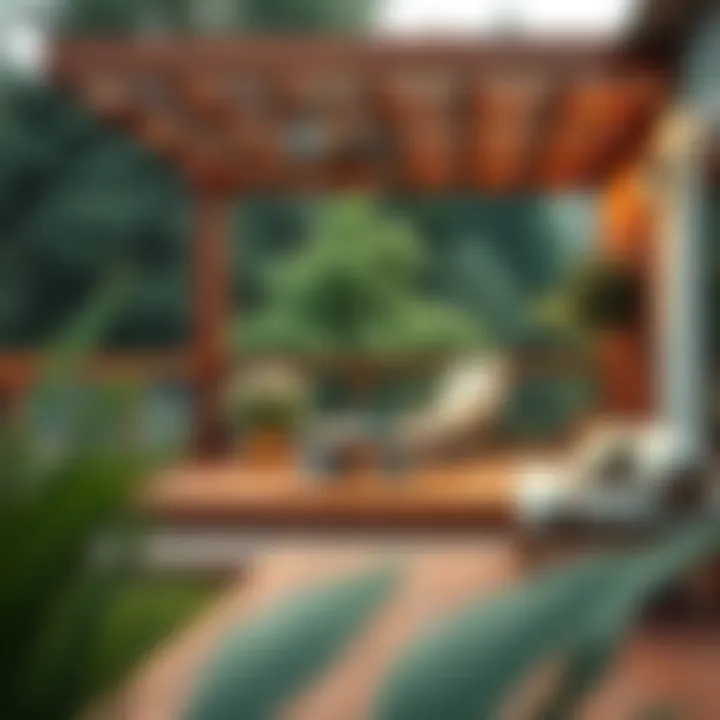
Preparation and Planning
Before bending over backwards to install your non-permanent deck, preparation is key. Think of it as laying the groundwork, much like a painter prepping a canvas. The first step is to assess the space where the deck will sit. Measure the area, consider the shape, and even sketch a rough layout. This can help visualize how your new deck will fit with existing structures or plantings.
Additionally, checking local zoning laws or homeowner association guidelines can save you from future headaches or fines down the road. Be aware, restrictions may dictate what kind of decks you can install, and knowing this ahead of time is essential. Moreover, collecting the necessary permits is a must if required.
Key Considerations Include:
- Size and Shape: Understand how the space will accommodate your deck.
- Local Regulations: Research the laws that apply to temporary structures in your area.
- Utility Lines: Ensure there are no underground pipes or wires that could disrupt the installation.
Step-by-Step Installation Guide
Now, let's roll up our sleeves and get into the nitty-gritty of installing your non-permanent deck. Following a step-by-step approach can simplify the process and minimize errors. Here’s a practical guide that outlines the main steps:
- Lay a Foundation: If your decking material demands it, start with a solid, leveled base. For many non-permanent decks, this might not be a concrete slab, but rather just a stable layer of gravel or compacted soil.
- Assemble the Frame: Using boards or composite materials, construct the perimeter of your deck. This frame acts like the backbone, holding everything together.
- Install Support Beams: Place beams across the frame at regular intervals. Depending on the materials, this may require additional bracing to maintain strength and balance.
- Lay the Decking Material: Whether it's tiles or composite boards, carefully lay each piece. Pay attention to spacing for expansion, especially with wood products that may swell with moisture.
- Finishing Touches: Ensure everything is secured. Check for loose boards, and consider applying a sealant if your material requires added protection from the elements.
Tools Required for Installation
Having the right tools on hand can save you time and frustration. Here’s a handy checklist to ensure you're not scrambling halfway through the project:
- Measuring Tape: For precise measurements to prevent any gaps or overlaps.
- Circular Saw: To make clean cuts on decking materials.
- Drill: For driving screws, essential for securing boards.
- Level: To ensure your deck is perfectly flat.
- Rubber Mallet: Great for fitting tiles snugly without cracking them.
- Safety Gear: Always a must; gloves and goggles for protecting yourself during installation.
"Planning and preparation before you start setting up your non-permanent deck can stretch the duration of its usability considerably."
Following these installation techniques with care will not only ensure the structural integrity of your non-permanent deck but also enhance the enjoyment of your outdoor space.
Maintenance and Care
In the discussion of non-permanent decks, maintenance and care are pivotal aspects that shouldn't be overlooked. While the initial appeal of these solutions lies in their adaptability and ease of installation, the longevity and aesthetics of a deck fundamentally depend on how well it is maintained over time. Proper care not only enhances the deck's lifespan but also ensures that it remains a safe and inviting space for outdoor activities. Let's delve into the specifics of maintaining these versatile structures.
Regular Cleaning Practices
Routine cleaning is essential to preserve the visual appeal and functional integrity of non-permanent decks. Just like you wouldn’t want to live in a messy house, a clean deck invites relaxation and leisure. Here are some best practices to keep your deck looking sharp:
- Sweep Away Debris: A simple sweep can do wonders. Remove leaves, dirt, and other debris regularly to prevent mold and mildew build-up.
- Wash with Soap and Water: Once a season, give your deck a thorough wash using a mild soap mixed with warm water. This helps in removing dirt that settles in those little crevices.
- Use a Pressure Washer: If dirt build-up becomes stubborn, consider using a pressure washer, but keep the setting low to avoid damaging the surface.
- Inspect for Damage: While you clean, take the time to inspect for any wear or damage, such as loose tiles or warped boards. Addressing these issues early can save you from bigger headaches down the road.
"A stitch in time saves nine." Keeping up with maintenance tasks can prevent larger issues from cropping up.
Seasonal Preparations
Just like changing clothes with the seasons, your deck needs some love throughout the year too. Different seasons introduce unique challenges. Here's how you can prepare your non-permanent deck for year-round performance:
- Spring Cleaning: After a long winter, clean and inspect your deck. Remove any winter debris and apply a wood protector or sealant if your deck surface requires it.
- Summer Shielding: Hot sun can fade colors and dry out materials. Consider using UV-resistant coatings and placing sunshades or umbrellas to protect both the deck surface and those using it.
- Fall Prep: Before winter's chill sets in, ensure all autumn leaves are cleared. A good wash before the first snow can protect against staining.
- Winter Care: If you live in an area with heavy snow, brushing off snow accumulation will help prevent damage. Avoid using rock salt as it can deteriorate the deck material over time.
In all, the key to a long-lasting non-permanent deck lies in regular maintenance intertwined with seasonal preparations. Keeping your deck clean and assessing its condition can ensure it remains not just a functional space but a beautiful extension of your home.
Comparing Permanent Versus Non-Permanent Options
In current home improvement trends, decking solutions often find themselves in heated debates between the permanent and the non-permanent camps. With more people opting for outdoor living spaces, understanding these options becomes vital for efficient planning and investment. Let's dive into the crux of the conversation by dissecting the core elements: cost, durability, and aesthetic appeal—all of which significantly influence the decision-making process of homeowners, designers, and aspiring DIYers.
Cost Analysis
When it comes to pricing, the first instinct might be to glance at the sticker price of materials. Permanent decks, typically constructed from materials like cedar or composite, can run up a hefty tab due to their lasting nature and installation complexity. Considerations like labor costs also add up when hiring professionals for installations can raise the financial stakes even higher.
On the flip side, non-permanent decks yield a different story. Often constructed from budget-friendly materials like interlocking tiles or portable decking systems, they offer a more flexible pricing structure. Homeowners can save a tidy sum by handling installations themselves, thus making non-permanent options appealing on a financial level. Here's a breakdown:
- Permanent Decks: Higher initial investment, labor costs significant, but long-term investment can pay off if well-maintained.
- Non-Permanent Decks: Lower upfront costs, easier self-installation, which can lead to savings.
Clients need to weigh these costs carefully alongside the expected lifespan of their deck and their own budget constraints.
Long-Term Durability
Durability plays a fundamental role in the decision between these two options. Permanent structures, while often viewed as the heavyweight champions of outdoor installations, can indeed withstand the rigors of nature for an extended period. Materials like pressure-treated wood or composite can resist decay, prompting many homeowners to believe their investment is well justified over the years.
Nonetheless, non-permanent decks have made impressive strides in this arena. While they typically do not last as long as permanent ones, advancements in manufacturing processes have enabled products to boast increased resilience against weather elements. That said, property owners should be realistic about both the expectations and their ability to perform necessary maintenance. These temporary structures, if cared for properly, can still offer a solid return on investment.
Here's how to think it through:
- Permanent Decks: Can last decades with regular upkeep, much more resistant to wear.
- Non-Permanent Decks: Generally shorter lifespan, but easy to replace or upgrade, more flexible in adapting to changing tastes or seasons.
Aesthetic Flexibility
A hallmark of modern design is adaptability, and this area prominently favors non-permanent solutions. Aesthetic flexibility encompasses the ability to change the look and feel of outdoor spaces without overhauling the entire setup. Non-permanent decks allow homeowners to express individuality—swapping colors, designs, and layouts as trends evolve or personal tastes shift.
Permanent decking, while often regarded as more traditional, does possess a unique charm and sturdiness that add genuine value to a property. However, they lack the levels of customization available with non-permanent options. In selecting decking, consider the following points:
- Non-Permanent Decks: Easy to customize or remove based on seasonal changes, varied styles and materials available.
- Permanent Decks: Offers a classic appeal and enhances property value but can be costly to modify.
Case Studies of Non-Permanent Deck Implementations
Understanding how non-permanent decks function in various real-life situations can provide valuable insights to homeowners, designers, and DIY enthusiasts. By examining actual cases, we can uncover the nuanced benefits and considerations that come with these versatile structures. These examples not only demonstrate innovative design solutions but also reflect the unique needs of different environments. Case studies of non-permanent decks help inform and inspire, allowing others to envision what might work in their own spaces.
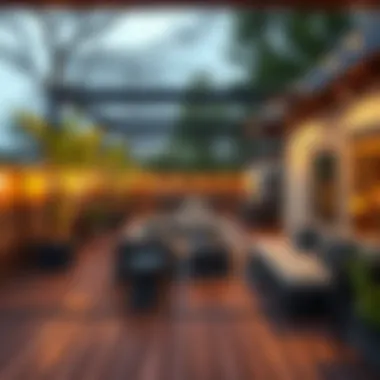
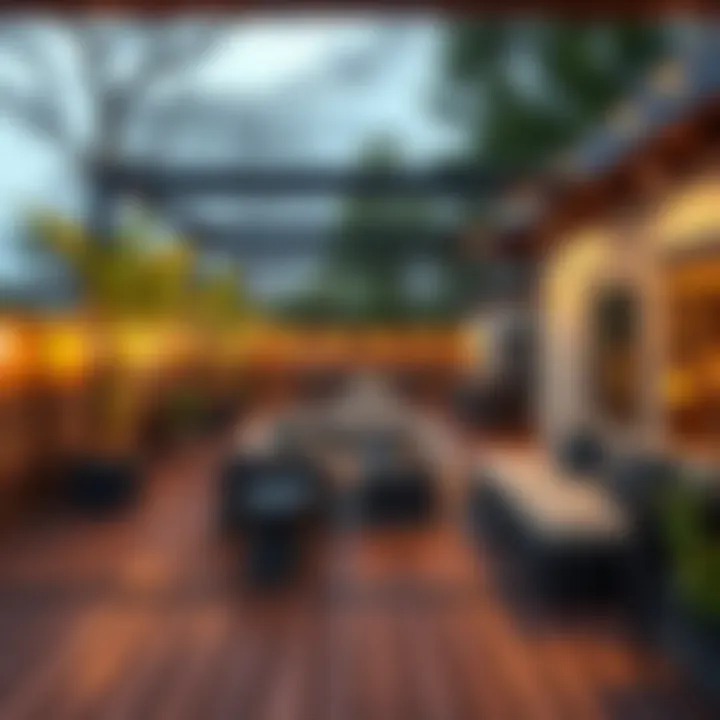
Urban Balcony Solutions
In densely populated urban environments, outdoor space is often at a premium. Non-permanent decks can transform underutilized balconies into vibrant living areas. For example, a small apartment in New York City used interlocking wood tiles to create a sprawling deck that extended the living space outdoors. The use of lightweight materials minimized structural concerns, while the ease of installation meant that the entire project took a weekend to complete—all without breaking any building codes.
Some crucial elements that emerged from this case include:
- Maximizing Vertical Space: Railings can be adorned with climbing plants or compact furniture can be incorporated to create a cozy nook.
- Weather Resilience: Selecting materials that can withstand rain while maintaining aesthetic appeal is vital. In this case, composite materials were chosen for their durability.
- Personal Touches: One homeowner added various potted plants and string lights, making the balcony a personal sanctuary.
This scenario emphasizes not just the functionality, but also the aesthetic value that can be achieved with thoughtful design choices. As one user on reddit noted, "It totally changed the way I enjoy my evenings."
Transformative Garden Spaces
In suburban settings, non-permanent decks can breathe new life into garden spaces. A case study from a family in Seattle illustrates how a temporary wooden deck can facilitate entertaining and family gatherings while offering simplicity in removing it for seasonal time, or if future renovation is needed.
Key aspects of this transformation included:
- Flexibility in Use: The deck functioned as a staging ground for family barbecues in the summer, yet it was easy to dismantle come fall, making way for seasonal clean-up.
- Integration with Nature: It was designed to level with the garden to minimize disruption to the landscape and encourage wildlife, enhancing the natural feel of the backyard.
- Cost Management: Using reclaimed wood kept costs low. This sustainable choice not only saved money, but gave the garden a unique character.
These examples highlight the potential for non-permanent decking solutions to enhance both aesthetics and functionality in various living conditions. In an ever-evolving landscape where outdoor living is becoming more essential, understanding these implementations can empower homeowners to make informed decisions about their own spaces. With each case study, we see the myriad ways to create livable, beautiful outdoor areas without the commitment of permanent installations.
Regulatory Considerations
When embracing the idea of non-permanent decks, it's crucial to navigate the landscape of regulations that govern the construction and use of these structures. Regulatory considerations play a significant role in ensuring that your deck is not only safe and durable but also compliant with local laws. Getting this right means avoiding potential fines and making sure your hard work doesn’t end up being dismantled.
Zoning Laws and Restrictions
Understanding zoning laws is paramount before you dive headfirst into deck-building. These laws dictate how land can be used within a specific area. Each locality has its own rules, which might restrict you based on factors like the dimensions of the deck, its placement concerning property boundaries, and even its intended use.
- Consult Local Authorities: Start by checking with your city or county zoning office. They can provide a wealth of information about regulations that may apply to your area, including whether a permit is required for your project.
- Setback Requirements: Many places have setbacks, meaning your deck must be a certain distance away from property lines. Understanding these can save you from potential headaches down the road.
- Homeowner Associations: If your residence is within a community governed by a homeowners' association, you might need to adhere to their additional guidelines and obtain their approval before beginning your project.
Getting all your ducks in a row will ensure a smoother process and prevent any nasty surprises.
Building Codes for Temporary Structures
Building codes for temporary structures are another critical piece of the puzzle. These regulations are designed to ensure safety and stability, even for decks that are intended not to be permanent. Here are the key things you should consider:
- Load-Bearing Requirements: Depending on where you live, building codes may dictate how much weight your non-permanent deck can support. This is especially crucial if you're planning to host gatherings with multiple guests, outdoor furniture, or even any form of greenery.
- Materials Compliance: The materials you use for a temporary deck must be compliant with local building codes. For instance, some materials might not be suitable depending on fire safety regulations.
- Installation Guidelines: Codes often specify how to properly install structures to ensure durability and safety, even if it's not meant to last forever. Ignoring these guidelines can not only lead to structural failures but might also have repercussions during inspections.
"Addressing zoning laws and building code requirements is not just a formality; it is your foundation for creating a safe and enjoyable outdoor space."
In summary, regulatory considerations are not obstacles but rather guideposts that help you create the outdoor space you envision while ensuring compliance with safety standards. Taking the time to understand local zoning laws and building codes will not only enhance your structural integrity but also provide peace of mind as you enjoy your non-permanent deck.
The Future of Non-Permanent Decks
The landscape of outdoor living continues to evolve, embracing the idea of creating inviting spaces without the long-term commitment of traditional structures. The future of non-permanent decks reflects a growing trend among homeowners eager to maximize their properties while retaining the flexibility to adapt to changing needs and styles. This shift is not just about aesthetics; it speaks volumes about sustainability, financial prudence, and the ever-increasing demand for multifunctional outdoor environments.
With urban spaces becoming more cramped and housing prices soaring, innovative decking solutions are becoming the go-to for those who want to make the most out of their outdoor areas without breaking the bank. Non-permanent decks allow homeowners to play around with designs, materials, and layouts, offering a unique opportunity to bring both functionality and flair to outdoor spaces. In this section, we’ll explore innovations in materials and the design trends to watch, highlighting how these elements are paving the way for a more versatile approach to outdoor living.
Innovations in Materials
As technology advances, so do the materials available for non-permanent decks. Traditional woods and concrete are giving way to a range of contemporary materials that enhance durability and aesthetic appeal without a heavy environmental footprint. One exciting development is the introduction of eco-friendly composites, made from recycled plastics and reclaimed wood fibers. These materials not only cut down on wastage but also offer superb resistance to weather elements, ensuring long-lasting beauty without the hassle of frequent maintenance.
Another game changer is the rise of modular decking systems, which allow homeowners to easily assemble and disassemble their decking area as needed. This means no more endless hours of installation work or the expense of hiring professionals. With a few tools and some creativity, DIYers can customize their decks to suit their specific needs.
Moreover, lightweight interlocking tiles are gaining traction. These tiles can be placed directly over existing surfaces, providing an instant upgrade with minimal fuss. They come in various styles and finishes, catering to the diverse tastes of homeowners who wish to express individuality through their outdoor spaces. In short, the future is bright for decking materials, combining innovation, sustainability, and user-friendliness.
Design Trends to Watch
As non-permanent decks gain popularity, they are also influencing broader design trends in outdoor spaces. One notable movement is the rise of biophilic design, which emphasizes a connection to nature through organic shapes, natural materials, and plant integration. Homeowners are increasingly incorporating elements like planters, vertical gardens, and wooden screens into their deck designs, creating seamless transitions between indoor and outdoor areas.
Another trend is the focus on multifunctionality in design. Homeowners are looking for decks that serve multiple purposes—ranging from hosting gatherings to serving as peaceful retreats.
- Modular Furniture: Homeowners are gravitating toward flexible furniture setups that can be easily moved and reconfigured based on the occasion.
- Integrated Lighting Solutions: Smart lighting that adjusts ambiance with app-controlled fixtures is making its way into deck designs, allowing for a cozy atmosphere come evening.
Furthermore, the concepts of open space and comfort are becoming more entwined, with homeowners opting for larger, uninterrupted surfaces that accommodate gathering areas, lounging spaces, and even spots for outdoor working. This trend taps into the continuing redefinition of living spaces in response to greater remote work flexibility.
"The innovative materials and ever-evolving design trends in non-permanent decking reflect the desires of today’s homeowners for style, sustainability, and flexibility."
By keeping an eye on these future trends in non-permanent decks, homeowners not only enhance their immediate living environments but also contribute to a more sustainable and adaptable approach to modern living. The combination of innovative materials and thoughtful designs ensures that non-permanent decks are not just a passing fad but a long-term solution to evolving lifestyles.
Epilogue
Recap of Key Points
- Benefits: Non-permanent decks offer incredible financial savings while allowing for seasonal changes and styles, making them ideal for diverse needs.
- Material Options: Today's materials, like wood composites and interlocking plastic systems, deliver both durability and visual appeal, significantly enhancing outdoor aesthetics.
- Installation and Maintenance: The ease of installation combined with straightforward maintenance routines translates to minimal hassle for homeowners.
- Regulatory Insights: Understanding zoning laws and building codes ensures compliance and comfort in using these structures.
- Future Directions: Innovations in design and materials promise exciting new pathways to explore, keeping non-permanent decks relevant in the evolving landscape of architecture.
Final Thoughts on Non-Permanent Decking
The take-home message here revolves around the significance of not just having an outdoor space, but having one that reflects personal style and adapts to lifestyle changes. Non-permanent decks aren’t merely an afterthought—they can be the heart of outdoor gatherings, a serene retreat, or an extended living area. The adaptability they offer ensures that whether constructing a cozy balcony oasis or a sprawling backyard retreat, options abound. With each seasonal shift, reconnecting with personal space becomes effortless.
The journey of creating outdoor environments is undoubtedly enriched by choosing non-permanent solutions. Embracing these practical yet stylish alternatives means not just enhancing property value, but also the quality of life itself.
The right outdoor setup can turn a house into a home and elevate everyday living experiences. Embrace the flexibility and creativity inherent in non-permanent decking solutions for your personal or professional projects.
For further insights, you can explore more on this dynamic topic at:
- Wikipedia - Deck
- Britannica - Home and Garden
- Reddit - DIY Deck Ideas
- Facebook - Home Improvement Groups







